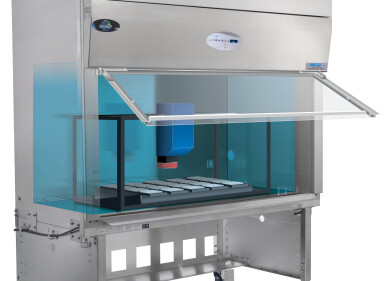Laboratory Products
Multispectral Imaging System Provides High Throughput Screening of Wheat Samples
Jul 16 2015
Analytik report on the work of researchers at the John Innes Centre in Norwich. The Videometer VL3 multispectral imaging system provides high throughput screening of wheat samples.
The BBSRC, the Department for Environment, Food and Rural Affairs (Defra) and HGCA, the cereals and oilseeds division of the Agriculture and Horticulture Development Board (AHDB) are funding a LINK project “A 'breeder's tool kit' to improve Hagberg Falling Number for the economic and environmental sustainability of UK wheat” in collaboration with four breeding companies in the UK and Europe to genetically map and understand the mechanisms of six previously identified QTL segregating in UK germplasm.
The research group of Cristobal Uauy within the Department of Crop Genetics are working on ways of screening wheat samples to improve parameters such as yield, nutritional value and quality. Research scientist, James Simmonds, takes up the story. “Our research focuses on the study of quantitative variation in wheat for agriculturally important traits. These are characterised by their dependency on the environment and the multiple genes that control them (known as quantitative trait loci (QTL)). We aim to understand the molecular mechanisms underlying these traits and to identify the genes underlying the QTL and facilitate their effective deployment into modern breeding varieties.” In depth phenotyping can be very time consuming and one of the group’s goals has been to find a faster way of screening to enable increased throughput, greater statistical evaluation and aid in interpretation. To this end, the JIC has invested in a VideometerLab 3 multispectral imaging system from Analytik and, together, have been developing protocols for screening.
Selection of the VideometerLab 3 system has provided an essential method for high-throughput screening of wheat samples segregating for levels of pre-harvest sprouting. Previously samples were scored by eye by counting out 100 grains and visually scoring the percentage number of grains showing germination. Now, Mr Simmonds says, “We estimate by having a trained automated system in place, we can process samples 10 times faster enabling us to handle and test many more samples.”
As Product Specialist, Adrian Waltho, says, “Previously John Innes Centre had to hire technicians to tip a hundred-or-so grains from each sample into a petri dish and count them one by one. Now, with their VL3 they can take an image and the software identifies and counts the grains. Grains are classified as sprouted, un-sprouted or invalid and results are delivered on an easy-to-understand spreadsheet. Now, the group may be able to look up to as many as 6,000 samples in a couple of weeks.”
Digital Edition
International Labmate 49.6 - Sept 2024
September 2024
Chromatography Articles - HPLC gradient validation using non-invasive flowmeters Mass Spectrometry & Spectroscopy Articles - From R&D to QC, making NMR accessible for everyone: Putting NMR...
View all digital editions
Events
Oct 08 2024 Gothenburg, Sweden
Oct 09 2024 Birmingham, UK
Oct 09 2024 NEC, Birmingham, UK
Oct 15 2024 Milan, Italy
Oct 17 2024 Dhaka, Bangladesh







.jpg)










